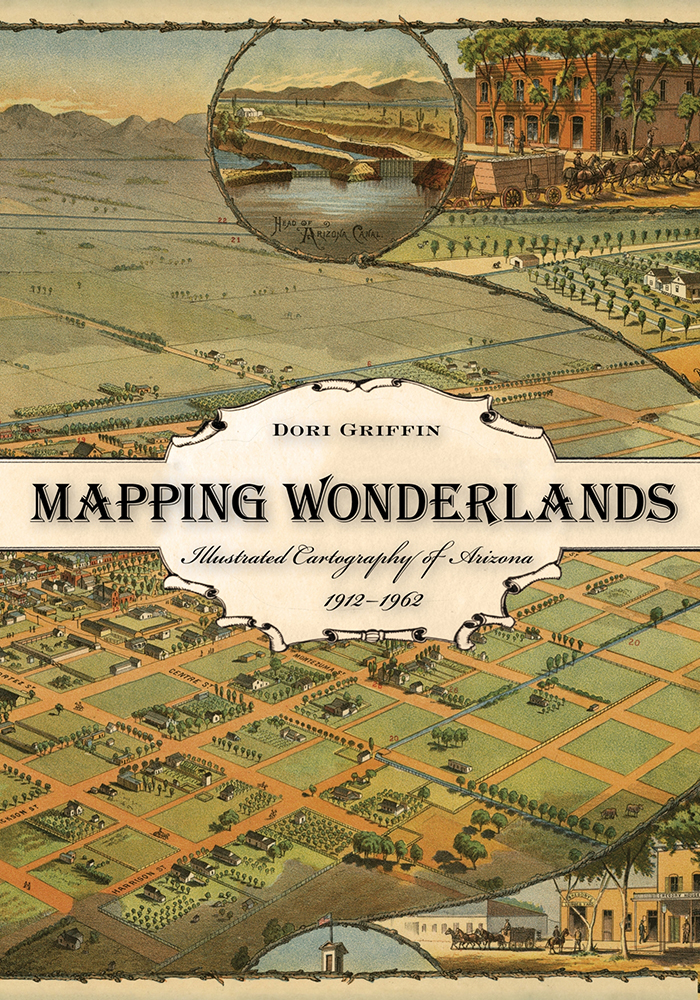Mapping Wonderlands
Illustrated Cartography of Arizona, 1912–1962
Hardcover ($57.00), Ebook ($57.00)
Buy
Though tourism now plays a recognized role in historical research and regional studies, the study of popular touristic images remains sidelined by chronological histories and objective statistics. Further, Arizona remains underexplored as an early twentieth-century tourism destination when compared with nearby California and New Mexico. With the notable exception of the Grand Canyon, little has been written about tourism in the early days of Arizona’s statehood.
Mapping Wonderlands fills part of this gap in existing regional studies by looking at early popular pictorial maps of Arizona. These cartographic representations of the state utilize formal mapmaking conventions to create a place-based state history. They introduce illustrations, unique naming conventions, and written narratives to create carefully visualized landscapes that emphasize the touristic aspects of Arizona.
Analyzing the visual culture of tourism in illuminating detail, this book documents how Arizona came to be identified as an appealing tourism destination. Providing a historically situated analysis, Dori Griffin draws on samples from a comprehensive collection of materials generated to promote tourism during Arizona’s first half-century of statehood. She investigates the relationship between natural and constructed landscapes, visual culture, and narratives of place. Featuring sixty-six examples of these aesthetically appealing maps, the book details how such maps offered tourists and other users a cohesive and storied image of the state. Using historical documentation and rhetorical analysis, this book combines visual design and historical narrative to reveal how early-twentieth-century mapmakers and map users collaborated to imagine Arizona as a tourist’s paradise.
Mapping Wonderlands fills part of this gap in existing regional studies by looking at early popular pictorial maps of Arizona. These cartographic representations of the state utilize formal mapmaking conventions to create a place-based state history. They introduce illustrations, unique naming conventions, and written narratives to create carefully visualized landscapes that emphasize the touristic aspects of Arizona.
Analyzing the visual culture of tourism in illuminating detail, this book documents how Arizona came to be identified as an appealing tourism destination. Providing a historically situated analysis, Dori Griffin draws on samples from a comprehensive collection of materials generated to promote tourism during Arizona’s first half-century of statehood. She investigates the relationship between natural and constructed landscapes, visual culture, and narratives of place. Featuring sixty-six examples of these aesthetically appealing maps, the book details how such maps offered tourists and other users a cohesive and storied image of the state. Using historical documentation and rhetorical analysis, this book combines visual design and historical narrative to reveal how early-twentieth-century mapmakers and map users collaborated to imagine Arizona as a tourist’s paradise.
"This fine book has important things to say about how the way Arizona told its story in the past impacts the way Arizonans, and the rest of the world, perceive the state today."—Helene Woodhams, Southwest Books of the Year
"Historical geographers who are interested in the roles that maps—as both representations and practices—play in the unfolding of place identities over time will find Mapping Wonderland a rich and useful extension of previous work."—Journal of Historical Geography
“Rich in content and beautifully illustrated, Mapping Wonderlands makes a major contribution to our understanding about the role of mapmaking in advertising and promotion.”—Richard Francaviglia, author of Over the Range: A History of the Promontory Summit Route of the Pacific Railroad
"Historical geographers who are interested in the roles that maps—as both representations and practices—play in the unfolding of place identities over time will find Mapping Wonderland a rich and useful extension of previous work."—Journal of Historical Geography
“Rich in content and beautifully illustrated, Mapping Wonderlands makes a major contribution to our understanding about the role of mapmaking in advertising and promotion.”—Richard Francaviglia, author of Over the Range: A History of the Promontory Summit Route of the Pacific Railroad
“This is an imaginative study, using the visual culture of tourism to explore the identity of Arizona, one that has broad implications for our understanding of the Southwest. Griffin has much to say about cultural memory and the touristic experience.”—Betsy Fahlman, author of Pennsylvania Modern: Charles Demuth of Lancaster
“Authoritative and well-researched. . . . A comprehensive study of a largely overlooked subject.”—Journal of Arizona History
“Authoritative and well-researched. . . . A comprehensive study of a largely overlooked subject.”—Journal of Arizona History
 The University of Arizona Press
The University of Arizona Press

